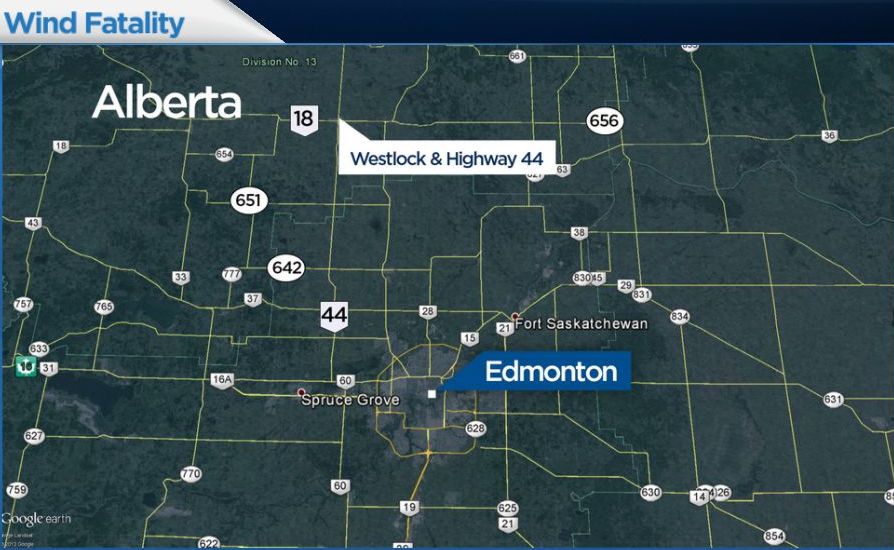Wicked winds whipping across much of Western Canada on Wednesday ripped down power lines, blew over semi-trailers, tore signs and awnings from their moorings and subjected pedestrians to a gale-force resistance workout.

RCMP in Alberta attributed at least two deaths to the blustery weather. They said a motorist who was checking his vehicle, which had become stuck after being blown into a ditch, was hit by a second vehicle that was also forced off the road by the wind.
Meanwhile, an 81-year-old woman was killed and five other people injured in a collision between a minivan and a car near Maskacis, formerly Hobbema. RCMP say weather was a factor in the crash.
Many flights scheduled to arrive in Winnipeg were rerouted due to the blowing snow. Four, including an Air Canada flight from Toronto, were diverted to Brandon, but two later were able to take off.
WestJet said two flights were diverted — a plane from Calgary to Winnipeg was rerouted to Thunder Bay, Ont., while another arriving from Thunder Bay was rerouted to Regina.
Environment Canada issued warnings for large parts of Alberta, Saskatchewan and Manitoba, as well as for a corner of British Columbia, about gusts reaching 90 to 100 km/h — or much higher in some areas.
Nearly 16,000 customers across northern B.C. were without power because of toppled trees and downed power lines. The hardest hit area was the South Peace River region in the province’s northeast, where speeds of 126 km/h were clocked at the Fort St. John airport Tuesday night when the windstorm swept in.
BC Hydro estimated electricity to some homes might not be restored until 11 p.m. Wednesday — more than 24 hours after it went out.
The Northern Rockies Regional Municipality opened a recreation centre in Fort Nelson, B.C., so people without power could get a hot meal and shelter.
“We have had numerous locations with gusts greater than 100 (km/h),” said Dan Kulak of Environment Canada. “This is not like a summer thunderstorm where you get gusts … (that are) very localized and very brief. We are having hours and hours at multiple locations … where winds are very strong.”
In Alberta, several RCMP detachments advised motorists that extremely high winds were making travel difficult. Drivers were advised to use caution on the Queen Elizabeth II Highway south of Edmonton. There were a number of reports of semi-trailer trucks and vans blown over, but no word of injuries.
The wind caused trouble during the morning commute in Edmonton, where a section of the light-rail transit line had to be closed because the wind was wildly whipping crossing arms at major intersections.
Debris strewn on streets hampered drivers, while twisted traffic lights caused signal malfunctions.
It was no calmer in Saskatchewan.
The Saskatoon Greater Catholic Schools division was not dismissing students over the lunch hour because of high winds and blowing debris. Parents were asked to pick up their children or drop off their lunches.
The city advised residents that it was preparing for potential service disruptions “as the force of such high winds may be destructive.” Utility and transportation crews were standing by.
A falling light standard crushed the roof of an empty car and a window was wrenched from a multi-storey building. A cellphone tower was bent in half, a roof was lifted off a building under construction and garbage bins were tossed about.
Power outages were being reported in several areas of the city as well as elsewhere.
School buses were shut down in the Biggar area, northwest of Saskatoon, due to slippery roads and gusting winds. That, after a bus with seven children slid into a ditch when the driver lost control. No one was hurt.
Crane operators were pulled from their jobs across the province. One general manager of a crane company said the maximum wind speed cranes can work in is 32 kilometres an hour.
Strong winds were also expected in Manitoba, where forecasters were predicting snow squalls and even a thunderstorm.
Natalie Hasell of Environment Canada said it was all due to the unstable air.
“We do get thunderstorms in winter time. It’s not unheard of. It’s … typically called thunder snow,” she said.
The wind did not sweep in a deep freeze. The weather was unseasonably mild with temperatures in many areas hovering around zero or climbing even higher.
Kulak said at least six temperature records fell across northern Alberta by mid-morning Wednesday. In Edmonton, the old record of 8 C set last Jan. 15 fell when the mercury hit 9 C early in the morning. Meanwhile, winds reaching 120 kilometres an hour also broke records.
A significant low-pressure system moving down from the Mackenzie Valley in the Northwest Territories was to blame for that, explained Kulak.
“(The low) is pulling a lot of warm Pacific air across southern Alberta and … we’ve had a number of temperature records for the day fall before the sun even came up,” he said.
“Really a very unusual day across the western part of the Prairies.”
The unstable weather was expected to head into Ontario overnight.


Comments